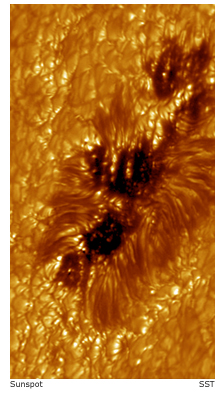|
Course Description - Review this in detail after first class
This course is meant as a descriptive introduction to a wide range of topics in astronomy for students who
are not science or math majors. The emphasis in this course is on description of astronomical phenomena,
how astronomical observations can be interpreted, and physical theories for the evolution of various types of
astronomical objects. Concerning the mathematical level, it is minimal in this course--I do not believe manipulation
of formulas demonstrates understanding, so I try to equalize the background differences by using very little math
in lectures, and almost (not quite) none on the exams. However you will encounter a few important but simple
formulas in the text whose understanding will be helpful, even crucial, throughout later sections of the course,
so please don't interpret this paragraph as suggesting that you should ignore the important equations! .
 You should also get used to seeing very large and very small numbers expressed in "scientific notation" (be sure
to read Appendix 1 of the text, at the end of the book, or at the web site, on this). Another thing that will be
very helpful is to develop a comfort with looking at graphs, if you're not comfortable already. Comfort with
scientific notation and graphs will greatly enhance the ease with which you comprehend concepts later in the
course, and so I urge you to spend some time on these matters early in the course. However most of the emphasis
in this class will be focused on a verbal-level presentation and understanding of the material. Generally, if you
can explain all the material in everyday language to someone who knows nothing about astronomy, you will
probably do well on the exams. If you struggle for terminology and know that you don't understand what you
just said, it is a sign that you need to study more.
You should also get used to seeing very large and very small numbers expressed in "scientific notation" (be sure
to read Appendix 1 of the text, at the end of the book, or at the web site, on this). Another thing that will be
very helpful is to develop a comfort with looking at graphs, if you're not comfortable already. Comfort with
scientific notation and graphs will greatly enhance the ease with which you comprehend concepts later in the
course, and so I urge you to spend some time on these matters early in the course. However most of the emphasis
in this class will be focused on a verbal-level presentation and understanding of the material. Generally, if you
can explain all the material in everyday language to someone who knows nothing about astronomy, you will
probably do well on the exams. If you struggle for terminology and know that you don't understand what you
just said, it is a sign that you need to study more.
The lectures will generally emphasize the most important and/or difficult topics covered in the text and attempt
to clarify their connections. The lectures will not cover every topic covered in the text that you are responsible for,
so don't assume that if it's not covered in lecture, it won't be on the exam; I will tell you in lecture (and on review
sheets before each exam) which parts of the text you can skip or are of minor interest. Similarly, there are a (very)
few topics to which I will add material not covered in the text. So you may find it a distinct advantage to attend
classes regularly, especially since some of the exam questions will be taken directly from lecture material, and
I am in the habit of asking questions during class that later magically appear on exams.
Because reading is all you have to do in this course (besides the homework consisting of self-test questions), I expect
you not to get behind. In particular, I will assume that you have tried to look over the relevant text material before
the corresponding lecture, so that the lecture can serve as a concentrated review and clarification. If you are coming
to class "cold," without having skimmed the material in the text, you will find yourself at a large disadvantage.
I have used this textbook many times, and have stayed with it partly because its writing is clear (as far as science writing
can be clear), and because of its visual materials. Please spend an hour leafing through the whole textbook so that you
have a feel for the kinds of topics we will cover, and the level of detail that you will encounter.
The texbook website contains a LOT of material, including the whole textbook, with links to updates on developments that have
occurred very recently, links between figures and topics in the text and animations; hyperlinks between all cross-links,
uber-meta-quasi-pseudo-hyperlinks, glossary terms, learning objectives; and other stuff. I will NOT hold you directly
responsible for any of this material that is not in the textbook. The website material can be perused at your discretion.
It should be emphasized, however, that some students report their understanding of the material strongly enhanced by,
say, looking at pictures and animations, so I want to encourage you to at least dabble around at the web site as we cover
each new topic. Use of this site is entirely optional EXCEPT for the use of the multiple choice self-testing module at that site.
(Click on Astronomy Today 6/e, then choose "Multiple Choice 1" and "Multiple Choice 2.") A separate handout will be passed
out listing specific suggested study guide questions for the first few exams.
|

